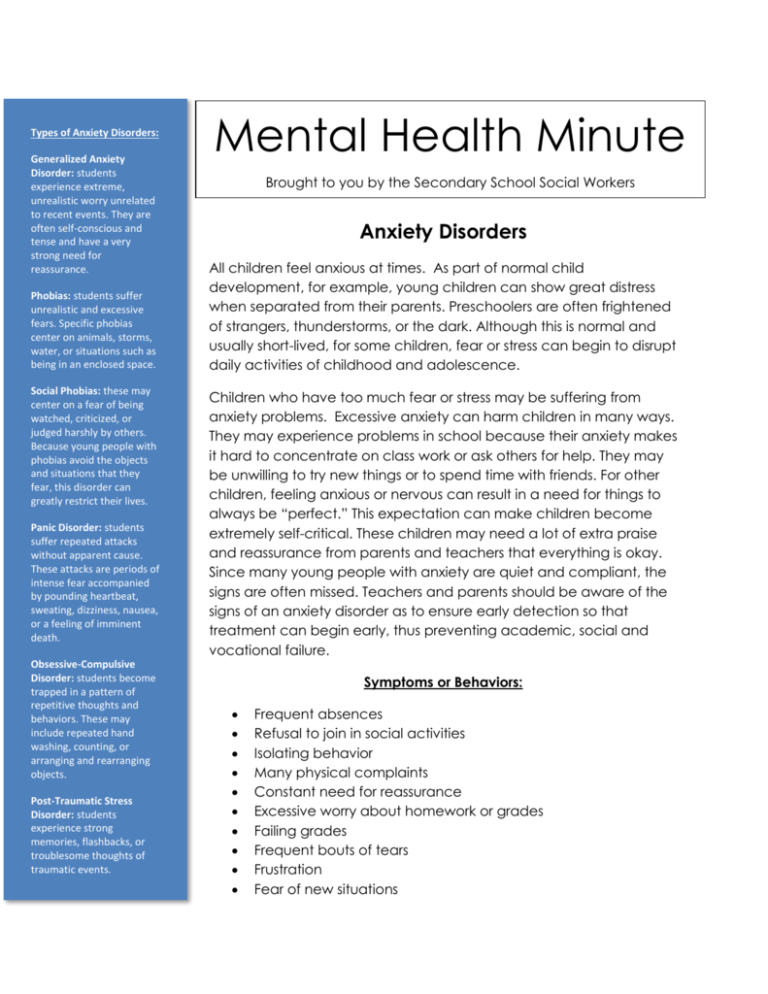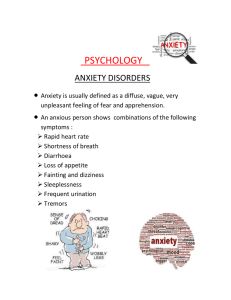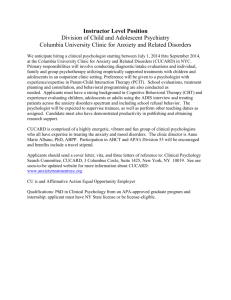Types of Anxiety Disorders
advertisement

Types of Anxiety Disorders: Generalized Anxiety Disorder: students experience extreme, unrealistic worry unrelated to recent events. They are often self-conscious and tense and have a very strong need for reassurance. Phobias: students suffer unrealistic and excessive fears. Specific phobias center on animals, storms, water, or situations such as being in an enclosed space. Social Phobias: these may center on a fear of being watched, criticized, or judged harshly by others. Because young people with phobias avoid the objects and situations that they fear, this disorder can greatly restrict their lives. Panic Disorder: students suffer repeated attacks without apparent cause. These attacks are periods of intense fear accompanied by pounding heartbeat, sweating, dizziness, nausea, or a feeling of imminent death. Obsessive-Compulsive Disorder: students become trapped in a pattern of repetitive thoughts and behaviors. These may include repeated hand washing, counting, or arranging and rearranging objects. Post-Traumatic Stress Disorder: students experience strong memories, flashbacks, or troublesome thoughts of traumatic events. Mental Health Minute Brought to you by the Secondary School Social Workers Anxiety Disorders All children feel anxious at times. As part of normal child development, for example, young children can show great distress when separated from their parents. Preschoolers are often frightened of strangers, thunderstorms, or the dark. Although this is normal and usually short-lived, for some children, fear or stress can begin to disrupt daily activities of childhood and adolescence. Children who have too much fear or stress may be suffering from anxiety problems. Excessive anxiety can harm children in many ways. They may experience problems in school because their anxiety makes it hard to concentrate on class work or ask others for help. They may be unwilling to try new things or to spend time with friends. For other children, feeling anxious or nervous can result in a need for things to always be “perfect.” This expectation can make children become extremely self-critical. These children may need a lot of extra praise and reassurance from parents and teachers that everything is okay. Since many young people with anxiety are quiet and compliant, the signs are often missed. Teachers and parents should be aware of the signs of an anxiety disorder as to ensure early detection so that treatment can begin early, thus preventing academic, social and vocational failure. Symptoms or Behaviors: Frequent absences Refusal to join in social activities Isolating behavior Many physical complaints Constant need for reassurance Excessive worry about homework or grades Failing grades Frequent bouts of tears Frustration Fear of new situations Educational Implications: Did you know?? Anxiety disorders are among the most common mental, emotional, and behavioral problems to occur during childhood and adolescence. About 13 of every 100 children and adolescents, ages 9 to 17, experience some kind of anxiety disorder. Nearly half of children and adolescents with anxiety disorders have a second anxiety disorder or other mental or behavioral disorder, such as depression. Among adolescents, more girls than boys are affected. Studies suggest that young people are more likely to have an anxiety disorder if their parents have anxiety disorders. Students with anxiety disorders are easily frustrated and may have difficulty completing their work. They may worry so much about getting everything right; it may take much longer to finish than other students. Or they may simply refuse to begin out of fear that they won’t be able to do anything right. Their fears of being embarrassed, humiliated, or failing may result in school avoidance. Getting behind in their work due to numerous absences often creates a cycle of fear of failure, increased anxiety, and avoidance, which leads to even more absences. Classroom Strategies and Accommodations: Allow students to contract a flexible deadline for worrisome assignments Consider modifying or adapting the curriculum to better suit the student’s learning style—this may lessen his/her anxiety Post the daily schedule where it can be seen easily so students know what to expect Encourage follow-through on assignments or tasks, yet be flexible on deadlines Reduce school work load when necessary Keep as much of the child’s regular schedule as possible Encourage school attendance Ask parents what works at home









